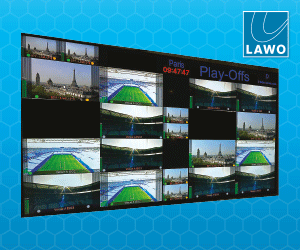The second panel looked at IP migration plans among MENA broadcasters, in association with Diversified. The aim was to understand their IP vision – whether they see operational benefits in moving to an IP-based system, what their current challenges are, and in what areas of their network they intend to begin the transition.
The conversation brought together Yusuf Al-Butti, Head of Technology and Engineering at twofour54; Afzal Lakdawala, Head of Technology Planning and Projects at Dubai Media Inc; David Clark, CTO of Sky News Arabia; and Andrew Davies, Director, Media & Entertainment EMEA, Diversified. Moderating the panel was Suhail Ahmed, CEO of One Diversified FZ LLC and the chief architect of this discussion.
After a dramatic beginning, quoting Pixar’s John Lasseter – “The art challenges technology, and technology inspires art” – Suhail Ahmed asked the panellists where we stand in terms of standards, given that the lack of standards is one of the critical reasons for the slow adoption of IP in most markets.
Giving the discussion further context, Andrew Davies pointed out that when the industry first started to introduce IP systems, they were primarily “proprietary systems and the whole ecosystem was based on a single vendor system sometimes”.
“As the markets have matured and the standards have also matured, we have seen that change and shift to best-of-breed systems. We are not quite there yet. There are still issues around control, but the launch of standards has helped us deliver projects to those standards over the years.”
Afzal Lakdawala of DMI seconded this, calling ST-2110 a very mature step. “With ST-2110 being ratified by SMPTE and accepted by all the vendors as the de facto standard for broadcast equipment moving forward on IP, broadcasters will now be more comfortable making the move to IP, since interoperability will not be a concern. Additionally, since ST-2110 standards are video format-agnostic, the long-term commitment will not be an issue.”
Everyone agreed that the lack of standards has been thus far a severe deterrent, but with this being addressed, there will be greater confidence in undertaking the migration.
Twofour54’s Yusuf Al-Butti pointed out that IP will indeed be the way forward, especially in remote production, which is one key area that will witness massive adoption of IP.
In a news environment where speed and efficiency are critical, David Clark, CTO of Sky News Arabia, noted that the broadcaster already benefits from using IP in some areas of the network.
On the contribution side, we are very heavily invested in IP. For our news gathering and live content, we are about 80:20 right now, where 80% of our content from a live capacity is delivered over an IP network or public internet.
“I think it comes down to where speed of getting content to a viewer in the broadcast chain, in a traditional studio set-up, can benefit from IP. Introducing an IP backbone should be about the efficiencies achieved by utilising a software-based technology stack. Essentially, the software should do more for a production with less, rather than simply giving the ability to connect box after box to baseband distribution chains.”
The comment on software led Ahmed to bring the discussion to how international players are responding to the decoupling of software and hardware, and the availability of vendor-agnostic commercial off-the-shelf (COTS) hardware to cater to their IP needs.
Referring to a slide Diversified presented, Davies showed how “more reliance on commercial off-the-shelf switches is allowing both broadcasters and systems integrators to tap into a much bigger market than we could ever sustain as a broadcast market”.
With the IT industry already having made huge leaps in this technology, the broadcast industry no longer has to reinvent the wheel and can instead leverage the R&D, manufacturing and solutions that IT has to offer. “We are now starting to see COTS hardware used more in America and Europe. We are seeing good adoption of those standards, and we have done several projects that have utilised those standards,” Davies pointed out.
Of course, with IP, Al-Butti noted that if the three corners of the triangle were previously the viewer, the technology and the content, telecoms has now entered that picture as a fourth party.
The panellists seemed to agree that an IP implementation at any of their facilities would indeed include a lot of accompanying hidden costs, such as revamping the infrastructure and connectivity, training staff and developing the team to deal with new technology.
When Ahmed questioned if the benefits of a reduced OPEX outweigh the cost and other challenges, Al-Butti said they do “if you utilise and develop all the IP features in your system”. Lakdawala, however, pointed out that:
“If you plan it right in a gradual step-by-step manner, these challenges can be overcome.”
However, he also remarked that in a large organisation like Dubai Media Inc, with substantial infrastructure deployments across production, post, transmission, OBs and SNGs, among others, IP implementation will be “a lengthy and gradual process that will take both time and effort”.
“We went through a similar cycle when we moved from an SD tape-based to a 3G, file-based system, and we invested heavily into that so we cannot overlook that fact. But there is also a limitation to how much a 3G infrastructure can grow. We are actively looking at higher resolutions, and this automatically implies that we will have to take the IP route.”
To one of Lakdawala’s concerns about using existing infrastructure, Davies responded that one of the major advantages of an IP solution is being able to undertake upgrades without necessarily replacing some of that infrastructure.
Ahmed brought the discussion back to cost, asking how Clark could justify an IP implementation within a news environment, where rough projections show that IP costs 20 times more than an SDI facility and twice the effort to get it up and running.
Clark agreed, stating that infrastructure is one of the key concerns.
“Contribution might definitely be via IP, but I do not foresee us implementing an IP backbone for our production facility, because getting that content from the field to an end user with quality and efficiency would be challenging. I would have to break a lot of things in a 24/7 production facility to go IP. But over time, the relationship of the human production side of things and how we would go into an IP world to put all those production elements together to assist the journalist telling the story, is where we will start to see a lot more investment.
“I don’t think the technologies are there to help us drive that just yet, but over time, and hopefully in a three-year time frame, we will start to roadmap exactly what that production backbone looks like to get that content across to the viewer with speed.”
But not every media house is sure of its IP roadmap, noted Davies, stating that sometimes clients “ask us for our opinion” and the systems integrator tries to understand “what exactly they are trying to achieve” and if “IP is really for them”.
“You need to analyse what the client wants to achieve, to determine whether IP is really the right fit for them. In the UK, we have done three 4K projects over copper and fibre. We are still seeing baseband installations sitting alongside a large stack of large-scale projects in IP.”
Lakdawala agreed that any decision on new technology implementations is determined by the business case and what the client wants to achieve. One business case does not work for all deployments.
“If you want to undertake virtualisation or a cloud-based infrastructure, your approach might be different from that of a client who wants to go with just higher resolution. It will all depend upon a client’s requirements and how they want to reap the benefits of an IP infrastructure.”
Davies agreed, but cautioned that clients often find it difficult to justify that business case in the short term.
“Some of these benefits will come in quite a few years’ time, and businesses are looking at ROIs within a two- or three-year cycle. We have sometimes found it difficult to justify the cost, although we know a client would actually reap benefits in a couple of years for that business.”
Al-Butti added here that there are substantial differences in how an entity like twofour54, which facilitates production, would benefit from IP, as opposed to broadcasters.
“An IP solution will help us at twofour54 to build more studios with less galleries. This means less capital expenditure, and this will reflect on the cost of the projects, and will give flexibility to use that infrastructure and technology in the long term. Therefore, the break-even time will be shorter for the benefit of the investment and the service cost. This is an important feature for us because we want to use a studio from one production to the next without any time lag.”
One of the big discussions the panellists circled back to was the importance of tapping into an IT-based infrastructure.
“If as a broadcaster I don’t look at investing in IP, I would still look at IP service-oriented architecture, because a service provider like twofour54, for instance, may have a return on that investment faster than I would,” commented Clark.
Another significant concern with IP has also been security.
“If you architect correctly in an IP world, there is no threat to security,” Clark reassured the audience, adding that as someone with experience working in security and the online space for the last five years, he has often tried to convince operators that a security service in the cloud is far more beneficial and secure.
Clarifying further, he said broadcasters have typically operated in islands.
“When you connect infrastructure to the internet, there is a risk. If you architect with security in mind and keep agile to continually improve the security posture, you mitigate that risk significantly and you keep moving away from a potential threat. There are smart people and companies to engage to help with this. The broadcast world previously kept their infrastructure on an island. Media demands today do not allow for this and the industry need not fear a connected world.”
The discussion on IT led Ahmed to question if it might be a good idea to get engineers with a different mindset to help “evolve our operations in broadcast” and “migrate away from the monolithic approach”.
Lakdawala said he would prefer to retrain a broadcast engineer, as people in broadcast environments are well trained to function in a broadcast ecosystem where no downtime is acceptable. Clark, however, pointed out that infrastructure engineers with experience working with large SaaS solutions may be in a better position to take an IP leadership role within an organisation.
Lakdawala agreed, but also expressed optimism that engineers within broadcast already have exposure to IP systems and with time, will eventually move in that direction.
“We have been working in one direction for so many years, so you can’t change a mindset overnight. As your infrastructure progresses in that direction, people will change how they function and develop.”
Davies agreed that training people is one of Diversified’s biggest challenges. It took the SI four to five years to train its internal workforce on how to deliver IP systems.
“Diversified decided to do an IP roadshow with fully operational IP systems in a couple of flight cases. We took that on the road and trained all our local offices, and that became an internal tool. Then companies started asking us if we could run that IP roadshow for them as well. It then became a useful tool, without investing in the actual technology for them to train on the system, and we plan to bring that to CABSAT next year.”
Ahmed concluded by asking if any of the panellists were making a move to IP in the future. Clark said not yet; Lakdawala commented that DMI was working towards an IP roadmap; and Al-Butti added that as twofour54 develops its new studios at its new facility in Yas Island, IP will be the technology of choice, with technical and operational readiness in place.
















































































